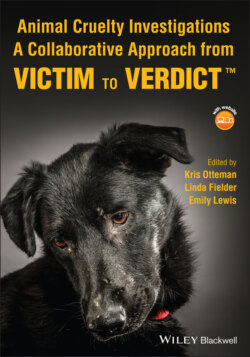Читать книгу Animal Cruelty Investigations - Группа авторов - Страница 137
3.8 Documenting Body Condition
ОглавлениеIt is helpful for staff conducting investigations to be trained in several species' body condition scoring methods. Knowing the bony points of an animal where fat stores are first depleted, such as the tail pins, the hip joints, and the ribs; these also serve as the key areas to observe when noticing the condition of an animal you cannot touch. It is important to make note in your reports of whether you assessed the animal using your hands or if you were unable to touch it. Here is an example of a statement regarding observations from a distance, “I was unable to enter the paddock where the horses were kept. Their coats were wet and from a 20‐foot distance I could easily count each horse's ribs and the tail pins were prominent on all four horses.”
Be sure you are documenting body condition according to the standard and not compared with other animals on the property. Universities around the country have published body condition scales, which are available online.1 Include a copy of the chart you utilized on site and refer to it as the standard you used when you write your reports. Share it with any veterinarians or other experts who will be examining the animals, so everyone is referencing the same body condition assessment scale in their examinations.
Photo and video documentation of body condition is very important and must not be overlooked. Familiarize yourself with the points on the body used to assess body condition and include those points in your videos and photographs. Make sure the light is adequate to display an accurate representation of what you see with your eyes, taking care not to exaggerate or underrepresent the body condition. Include five views of each animal (front, back, each side, and from above).
If an animal has a thick hair or feather coat, it can be helpful to use your hands when photographing, both to move the hair aside and as a caliper around the spinal column (Figure 3.6) (on a dog, for example) or to demarcate the prominent chest or keel bone of a bird.
